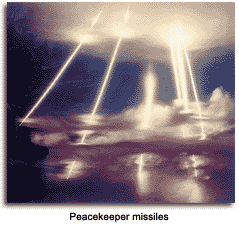The LGM-118 Peacekeeper Intercontinental Ballistic Missile is still best known by the acronym assigned it during development: MX, for Missile Experimental. For a variety of reasons, it became one of the more controversial missiles ever developed. Under the terms of arms reduction treaties with the Soviet Union, the Peacekeeper has been retired from service.
Consideration of a large, solid-propellant ICBM began in the 1960s, but the project was not officially launched until President Richard M. Nixon decided to fund the project in 1972. Although many contractors were used, Lockheed Martin was the program’s primary coordinator. With its cold launch system, the ICBM allows for a sustained nuclear conflict because silos could be refurbished and reloaded with another missile. By 1976, test components were being fabricated and by 1981, all four stages had been successfully tested on the ground. Under the terms of arms treaties, the fourth stage is not referred to as a stage due to its propulsion on the Post-Boost Vehicle (PBV). The first Peacekeeper was deployed at Warren Air Force Base in Wyoming in 1986.
 The objective was to produce a missile with Multiple Independent Reentry Vehicle MIRV warheads that would be powerful and accurate enough to knock out Soviet missile silos. With its counter-strike capabilities and an advanced guidance system, each 10-MIRV warhead Peacekeeper has a range of 5,965 miles and therefore is highly effective against multiple-hardened targets, knocking out 50 Soviet silos. But due to the Soviet’s deployment of road mobile systems, missile submarines, and an early warning radar system, such a counterstrike is futile.
That presented a siting dilemma, since the missiles would present such a valuable target to the Soviets that they could economically devote ten of their missiles to each launch site. The proposed solution was to place the MXs on a fast underground "racetrack," which would move the missiles from location to location so that the Soviets would not know where to aim their missiles against themFor this reason, it is likely that the Peacekeeper missiles were targeted at Soviet cities, in keeping with official US doctrine Since the plan was extremely expensive (estimated at $30 billion) and required a vast amount of dedicated land, it was deployed purely out of Minuteman missile silos.
In the face of strong opposition to the mobile plan, the {1958:Reagan] Administration decided in favor of siting the MX in Minuteman ICBM silos. This was feasible and economical, although it did not meet the survivability requirement originally established. A contingent of 50 missiles in Minuteman silos was decided on, with another 50 for mobile deployment in railcars. That plan was officially cancelled in 1991, due to expense and to give other countries less incentive to strike against them because there are fewer overall missiles deployed.
The fearsomeness of the Peacekeeper made it a casualty in arms reduction negotiations. Under the terms of SALT II, the Peacekeeper was eliminated from the U.S. arsenal. Although a technical pioneer, it was never produced in enough quantity to permit economical maintenance. A total of 114 missiles were produced, including spares and test missiles to back up the 50 deployed. At a program cost of around $20 billion, that worked out to around $400 million per deployed missile.
The objective was to produce a missile with Multiple Independent Reentry Vehicle MIRV warheads that would be powerful and accurate enough to knock out Soviet missile silos. With its counter-strike capabilities and an advanced guidance system, each 10-MIRV warhead Peacekeeper has a range of 5,965 miles and therefore is highly effective against multiple-hardened targets, knocking out 50 Soviet silos. But due to the Soviet’s deployment of road mobile systems, missile submarines, and an early warning radar system, such a counterstrike is futile.
That presented a siting dilemma, since the missiles would present such a valuable target to the Soviets that they could economically devote ten of their missiles to each launch site. The proposed solution was to place the MXs on a fast underground "racetrack," which would move the missiles from location to location so that the Soviets would not know where to aim their missiles against themFor this reason, it is likely that the Peacekeeper missiles were targeted at Soviet cities, in keeping with official US doctrine Since the plan was extremely expensive (estimated at $30 billion) and required a vast amount of dedicated land, it was deployed purely out of Minuteman missile silos.
In the face of strong opposition to the mobile plan, the {1958:Reagan] Administration decided in favor of siting the MX in Minuteman ICBM silos. This was feasible and economical, although it did not meet the survivability requirement originally established. A contingent of 50 missiles in Minuteman silos was decided on, with another 50 for mobile deployment in railcars. That plan was officially cancelled in 1991, due to expense and to give other countries less incentive to strike against them because there are fewer overall missiles deployed.
The fearsomeness of the Peacekeeper made it a casualty in arms reduction negotiations. Under the terms of SALT II, the Peacekeeper was eliminated from the U.S. arsenal. Although a technical pioneer, it was never produced in enough quantity to permit economical maintenance. A total of 114 missiles were produced, including spares and test missiles to back up the 50 deployed. At a program cost of around $20 billion, that worked out to around $400 million per deployed missile.